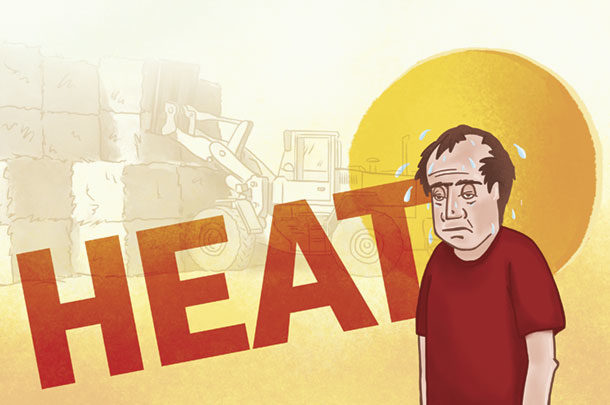It is important everyone understands how to work safely in the hot weather to prevent any heat-related illnesses and what to do if symptoms start to arise.
Heat stroke
Heat stroke occurs when the body fails to regulate itself, and the temperature of the body rises.
Symptoms
- Rapid pulse
- Hot, dry, reddish skin
- High body temperature with chills
- Confusion and slurred speech
- Lack of sweating
First aid
- Move into a cool place, out of direct sunlight.
- Remove any unnecessary clothing.
- Cool the body with cold water or ice packs, if possible.
- Never take aspirin or acetaminophen (Tylenol). (It negatively impacts the body’s internal temperature regulation.)
Heat exhaustion
 There are two types of heat exhaustion:
There are two types of heat exhaustion:
1. Water depletion. This is caused by lack of water. Signs include excessive thirst, weakness, headache and possibly loss of consciousness.
 2. Salt depletion. This occurs when your body is lacking body salt and minerals. Signs include nausea and vomiting, muscle cramps and dizziness.
2. Salt depletion. This occurs when your body is lacking body salt and minerals. Signs include nausea and vomiting, muscle cramps and dizziness.
Additional symptoms can include:
- Muscle cramps
- Excessive sweating
- Clammy skin and flushed complexion
- Weakness or fatigue
- Dizziness or confusion
First aid
- Move the person out of the heat and into a shady or air-conditioned place.
- Lay the person down and elevate the legs and feet slightly.
- Remove tight, heavy and unnecessary clothing.
- Have the person drink cold water. Cool the person by spraying or sponging with cool water and fanning them.
Heat cramps
 Heat cramps occur in muscles and are caused by lack of salt and water in the body.
Heat cramps occur in muscles and are caused by lack of salt and water in the body.
Symptoms
- Painful cramps in the body’s muscle
- Excessive sweating
- Muscle pain usually in the abdomen, arm or legs
- Muscle spasms usually in the abdomen, arm or legs
First aid
- Rest briefly and cool down.
- Drink clear juice or an electrolyte-containing sports drink (i.e., Gatorade).
- Practice gentle, range-of-motion stretching and gentle massage of the affected muscle group.
- Avoid strenuous activity for several hours or longer after heat cramps go away.
Heat rash
 Heat rash is a visible rash on the body and is caused by blocked sweat ducts, which irritates the skin, thereby causing a rash.
Heat rash is a visible rash on the body and is caused by blocked sweat ducts, which irritates the skin, thereby causing a rash.
Symptoms
- Red cluster of pimples or small blisters
- Usually found on neck and upper chest, groin area, underneath the breasts and in elbow creases
- An irritation of the skin cause by excessive sweating
First aid
- Remove any tight clothing and move to a cool, shady spot.
- Let the skin air-dry instead of using a towel.
- If the skin is irritable when touched, calamine lotion or hydrocortisone cream may be used with your doctor’s approval.
- Avoid ointments and lotions, as they can irritate the skin.

Cheryl DeCooman, CHRL, can also be reached at (519) 532-2508 or on Twitter and Instagram.
References omitted but are available upon request. Click here to email an editor.

-
Cheryl DeCooman
- President
- People Management Group
- Email Cheryl DeCooman
10 safety tips for working in hot weather
- Drink lots of liquids. You should be drinking about 16 ounces (2 cups) before starting work and 5 to 7 ounces (3/4 cup) every 15 to 20 minutes to stay hydrated. Water is ideal.
- Avoid dehydrating liquids. Any drinks containing alcohol, coffee, tea and caffeinated soft drinks can dehydrate you. If you need your cup of joe in the morning, try to drink 1 cup of water for every 1 cup of coffee.
- Wear protective clothing: Always try to wear lightweight, light-coloured and loose-fitting clothing; it helps to protect you against heat and sun. Change your clothing if it is damp or wet. Wear a wide-brimmed hat to protect your head, ears and neck.
- Pace yourself. Know your own limits and ability to work safely in heat.
- Take breaks. Take time for rest periods and water breaks in a shaded or air-conditioned area.
- Have a damp rag. Use a damp rag to wipe your face or put it around your neck to help to cool you down.
- Wear sunscreen to protect yourself from sunburns.
- Know the signs of heat-related illness. Know what to look for and check on other workers that might be at high risk.
- Avoid working directly in the sun. If possible, find shade or block out the sun.
- Eat small meals, high in fibre. Eat fruits high in fibre and natural juice (i.e., apples, oranges, strawberries). Avoid eating high-protein foods. (It takes the body longer and more energy to break down protein.)









